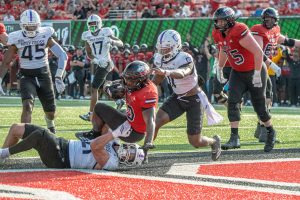Gymnastics tries to change dangerous image
March 16, 2004
On the sidelines at NIU gymnastics meets this year there was a full display of hospital equipment supporting injured Huskies.
Even though injuries are decreasing within gymnastics, this image has portrayed the sport as being dangerous.
In 2000, 52 percent of gymnastics injuries resulted in seven or more days lost and 16 percent required surgery, according to the NCAA Injury Surveillance System.
The most common injuries are sprains and rolled ankles, but gymnasts also deal with serious injuries such as torn tendons and damage to the anterior cruciate ligament.
Despite possible injuries, the National Association for College Gymnastics Coaches for Women is trying to change the image of gymnastics.
“[Our image] is a subject that we talk a lot about at the NACGCW meetings each year,” NIU gymnastics coach Mark Sontag said. “The NCAA puts out statistics on the injuries every year, but the statistics look a lot higher than the reality.”
Gymnasts lose more time per injury than most athletes, but it’s usually not severe. However, gymnasts must use their entire body to compete unlike other athletes, Sontag said.
“In a sport like football, a player can break his hand and still play with a cast, but in gymnastics, it’s different,” Sontag said. “In gymnastics, if you sprain a wrist or something like that, you cannot compete for every part of the body is needed and essential. A lesser injury has a much bigger impact in our sport.”
Severe injuries in 2000 have prompted the NCAA Committee on Competitive Safeguards and Medical Aspects of Sports to discuss strategies to reduce injuries in the sport with women’s gymnastics coaches.
The NCAA and NACGCW have started to make changes to combat these injuries. Changes include using better mats and equipment along with newer training facilities and trainers.
According to the 2003 ISS report, the new emphasis on safety has led to the decrease in injuries. Injuries resulting in seven or more days lost went down to 40 percent in the past three years, and those requiring surgery decreased to 14 percent.
“Of course injuries are an issue in our sport,” Sontag said. “I have been around this sport a long time, so you get used watching girls make mistakes and get injured. But you learn how to deal with it.”






